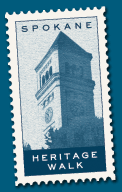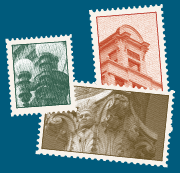
Spokane History
Founded in 1873 by James Nettle Glover, Spokane was first a small settlement known as Spokan Falls (it wouldn't be until 1883 that the "E" was added to Spokan, making the city known as Spokane Falls; in 1891, Falls' was dropped). The natural resources of Eastern Washington- fertile soil, timber, and mineral wealth- eventually attracted more settlers to the area. The present boundaries of Spokane County were created by the legislature in 1879. Incorporated in 1881, Spokane Falls became the county seat in 1887 after a hotly contested battle with Cheney.
The year 1889 was an eventful one in the Pacific Northwest when Spokane Falls, Seattle, and Ellensburg were destroyed by disastrous fires. Known as a night of terror devastation, suffering and awful woe, Spokane's response to the Great Fire of 1889, which destroyed 32 blocks of the central portion of the city, was to rebuild immediately, and in a far grander fashion of substantial and elegant brick, stone and terra cotta.
Spokane was transformed when the Northern Pacific Railroad arrived in 1881 and was linked transcontinentally in 1883. In that same year, Spokane experienced its first boom when the discovery of gold in the Coeur d'Alene mining district established Spokane as the service center for the north Idaho mines. Spokane suddenly became the center of regional commerce, becoming the main gate to the Pacific Northwest and establishing the Inland Empire which stretched from southern British Columbia to Oregon's Blue Mountains, from the Cascades to the Rockies. Railroad maps showed the metropolis of Spokane as the center, or Imperial City, of the Inland Empire. Spokane's influence was so great during this period that radical ideas arose of making Spokane its own state! Local investors funded by money made in the mines, quickly helped rebuild the city following the fire of 1889. Such was the flurry of construction and concentration of commercial buildings in the downtown core between the base of the South Hill and the Northern Pacific tracks that Railroad Avenue, where the tracks of the Northern Pacific were located, was elevated above street level in 1914-15 in an effort to eliminate traffic problems downtown. Railroads influenced both the development and appearance of Spokane. Railroads made Spokane the hub of the Inland Northwest, transporting new citizens into town and carrying out the wealth of the region.
Rebounding from a national depression in 1893, Spokane experienced another building boom at the turn of the century. Construction again expanded the downtown area, and the city nearly doubled to 37 square miles in 1907 when the city limits were extended. With a population of just over 300 in 1880, Spokane had grown in leaps and bounds to over 100,000 people by 1909, making the city, at the time, larger than Salt Lake City and the largest city west of Minneapolis. In that same year, Spokane boasted fourteen millionaires, 23 public schools, and over $4 million in new construction in just the first six months of that year. With the greatest water power west of the Niagara, Spokane, the largest city between Minneapolis and Seattle, was touted as a great place to live, a fine place to get an education, with the finest hotels, and the greatest diversity of architecture in any city of its size in the United States.
With Spokane's boom surprising many people who came here, forward thinking town leaders formed the city parks board in 1907 and brought the Olmsted Brothers from Brookline, Massachusetts in 1909 to advise and plan in order to ensure that Spokane would continue as the City Beautiful.
Spokane has retained much of its history through its buildings. Over 50% of Spokane's downtown is designated as historic, and makes up three separate National Register Historic Districts. Infact, the City of Spokane has the most designated National Register Historic Districts in the state with 18 total districts. Spokane is also home to the state's largest National Register District, Nettleton's Addition in the West Central neighborhood.
Spokane Architecture

Spokane began as a settlement with a mere handful of people in 1873. By 1889, Spokane had nearly 20,000 people. In that same year on August 4th, fire fueled by high winds and dry summer temperatures devastated over 30 blocks in the central portion of the city. Numerous original wood and brick buildings were destroyed, leaving behind smoldering rubble, uninsured businessmen, and a downtown made up of tents, known as tent city. The smoke had not yet abated when businessmen, lawyers, and insurance adjustors alike were sending away for tents to shelter their businesses. Some tents were deemed less than desirable. Noisy canvas saloons and beer halls appeared all over town. Gambling became a favorite past time in tent city as well. Gambling fever wasn't only found in the make-shift beer halls and saloons however, but also in the post-fire real estate market. Downtown lots were exchanged, purchased, and quickly sold. Rising from the ashes of the great fire that decimated the town, Spokane experienced a unique building boom that established the historic buildings seen in the downtown core today. A city of handsome business blocks- a new era of prosperity- how a beautiful city rises out of the ashes, through the enterprise and energy of its citizens gushed the souvenir booklet issued for the 1890 Northwest Industrial Exposition held in Spokane: Scarcely a year passed and upon the debris stands a city more majestic, more substantial and more costly than older cities on the continent. Spokane's rebirth resulted in about 100 new elaborate brick, masonry, and terra cotta commercial buildings in the downtown in the year immediately following the fire. Mostly designed by trained architects, names like Herman Preusse, Kirtland K. Cutter, and John K. Dow would be forever imprinted in history as being associated with the rebuilding of the city's downtown. Many of Spokane's most recognizable structures were built immediately following the fire by prominent architects. These include the Fernwell Building, the Bennett Block, the Review Building, and the Coeur d'Alene Hotel. In the decades following the fire, other landmark structures were constructed including the Spokane County Courthouse, the American Legion Building, the Paulsen Building and the Old National Bank Building, Spokane's first two skyscrapers. After 1910, Spokane gained the Davenport Hotel, the Spokane Club, Lewis& Clark High School, and the Monroe Street Bridge. The 1920s and 30s also brought Spokane the Chronicle Building, the Montgomery Ward Building (City Hall), the Fox Theater, and the Rookery Building.
Much of Spokane's historic buildings have been preserved and are currently still in use. In fact, over 50% of Spokane's downtown buildings are historic. Several buildings have also undergone extensive renovation over the last few years. The American Legion Building, designed by architect J.K. Dow and constructed in 1901 for businessman F. Lewis Clark, was home to the Spokane Club and later the Chamber of Commerce. In 1910, the building sustained severe damage following a kitchen fire in an upper story hotel. The entire roof was destroyed and the building for many years simply had a flat roof line. Vacant for much of the 1980s and 90s, the building was completely renovated in 2003 and the original mansard roof was rebuilt. Currently, the building houses several businesses and a day spa.
The Davenport Hotel was completely renovated as well beginning in 2000. Designed by famed architect Kirtland K. Cutter for Louis Davenport in 1911, the world famous hotel operated continuously for 71 years until it was closed after decades of decline in 1985. Following a series of ownership changes, the hotel was purchased by Walt and Karen Worthy in early 2000 and renovation immediately began to bring the hotel back to its original grandeur. Extensive restoration of the hotel included the complete removal of the famous ballroom the Hall of Doges in 2001. Weighing in at 30 tons, the Hall of Doges, the social center for dances and balls, was removed by two separate cranes from the now demolished Davenport Restaurant, completely restored, and reinstalled in the new east addition of the hotel. The hotel reopened following renovation in 2002.
In 1996, the Central Steam Heat Plant, closed for 10 years when it was no longer deemed economically beneficial, was renovated for use as office and retail space, and as a restaurant. Designed by architect Kirtland Cutter and partner Karl Malmgren, the Steam Plant, considered innovative for the time, was constructed in 1916 and provided boiler-generated steam power to a majority of downtown Spokane's buildings and businesses for 70 years.
The historic renovation of the American Legion Building, Davenport Hotel, and the Steam Plant Square, have ushered in a new era in downtown Spokane where what was old, is now new again. Numerous other historic buildings have been renovated for use as office and commercial space, hotels, and for downtown living.